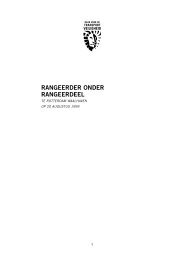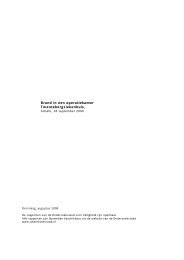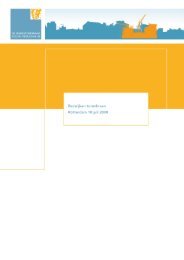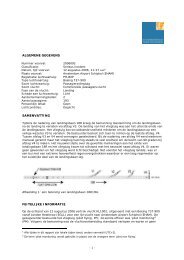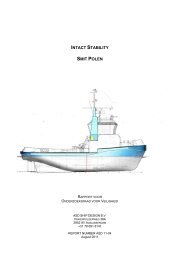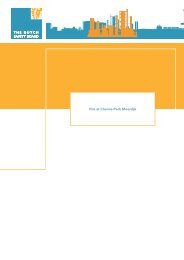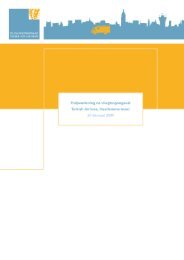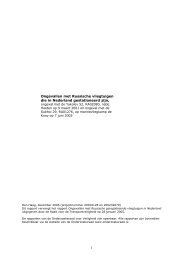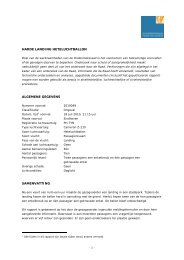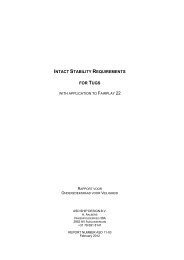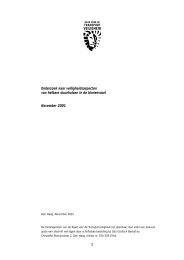Rejected takeoff after the takeoff decision speed 'V ', Boeing B737 ...
Rejected takeoff after the takeoff decision speed 'V ', Boeing B737 ...
Rejected takeoff after the takeoff decision speed 'V ', Boeing B737 ...
You also want an ePaper? Increase the reach of your titles
YUMPU automatically turns print PDFs into web optimized ePapers that Google loves.
Irregular<br />
indications <strong>speed</strong><br />
trend vector<br />
V 1<br />
150<br />
air<strong>speed</strong><br />
90<br />
The [knots] reason for <strong>the</strong> large lateral accelerations 140 147 was probably caused by an external, possibly<br />
atmospheric, phenomena. This would be a third time an anomaly could be related to an outside<br />
atmospheric phenomena. Up to this moment in time no warnings or failures were recorded on <strong>the</strong><br />
flight data recorder.<br />
start of <strong>the</strong> runway<br />
end of <strong>the</strong> runway<br />
5.2.4 <strong>Rejected</strong> <strong>takeoff</strong> roll<br />
aircraft<br />
Data from <strong>the</strong> autothrottle and flight data recorder rotationindicated that <strong>the</strong> <strong>takeoff</strong> was rejected at<br />
152 knots, which was above <strong>the</strong> 141 knots V 1<br />
<strong>speed</strong> determined by <strong>the</strong> crew. The applicable V 1<br />
<strong>speed</strong> was obtained prior to <strong>takeoff</strong> from <strong>the</strong> regulated <strong>takeoff</strong> mass (RTOM) tables presented in<br />
<strong>the</strong> aircraft manual. Included in this manual are circumstances in which <strong>the</strong> V-<strong>speed</strong> need to be<br />
air<strong>speed</strong><br />
adjusted (runway condition, runway slope, wind 150 conditions 160 or temperature etc). On <strong>the</strong> day of <strong>the</strong><br />
[knots]<br />
152<br />
event no adjustments were made nor were <strong>the</strong>y required.<br />
start of <strong>the</strong> runway<br />
end of <strong>the</strong> runway<br />
rejected <strong>takeoff</strong> roll<br />
air<strong>speed</strong><br />
[knots]<br />
160 0<br />
Figure 9: Timeframe of <strong>the</strong> rejected <strong>takeoff</strong> starting from <strong>the</strong> maximum of 160 knots to standstill.<br />
The available runway length at Eindhoven and wea<strong>the</strong>r conditions at <strong>the</strong> day of <strong>the</strong> event were not<br />
a limiting factor for <strong>the</strong> aircraft. Favourable conditions (aircraft weight and good runway friction)<br />
were present. The friction coefficient of 0.81 means that <strong>the</strong> braking action was good. The runway<br />
length of 3000 metres was sufficient and <strong>the</strong> flight crew elected to request exit GOLF during taxi,<br />
<strong>the</strong>reby utilising <strong>the</strong> full length of <strong>the</strong> runway. The aircraft stopped approximately 500 metres from<br />
<strong>the</strong> runway end despite rejecting <strong>the</strong> <strong>takeoff</strong> at a <strong>speed</strong> above V 1<br />
.<br />
The information available in this investigation and <strong>the</strong> flight data show that <strong>the</strong> aircraft systems were<br />
operating normally and no warnings were given for system malfunctions. The collected information<br />
fur<strong>the</strong>r shows that during <strong>the</strong> <strong>takeoff</strong> roll <strong>the</strong> aircraft experienced an undetermined atmospheric<br />
disturbance. The first officer felt and interpreted this disturbance as an unsafe condition to continue<br />
<strong>the</strong> <strong>takeoff</strong>. This feeling led to <strong>the</strong> <strong>decision</strong> to reject <strong>the</strong> <strong>takeoff</strong> <strong>after</strong> <strong>the</strong> <strong>takeoff</strong> <strong>decision</strong> <strong>speed</strong> V 1<br />
.<br />
5.3 REJECTED TAKEOFF PROCEDURES RYANAIR<br />
Procedures are laid down for pilots to help <strong>the</strong>m in <strong>the</strong> <strong>decision</strong> process to reject a <strong>takeoff</strong>. In <strong>the</strong><br />
Quick Reference Handbook (QRH) two procedures are written down under which circumstances <strong>the</strong><br />
<strong>takeoff</strong> should be rejected. It must be noted that <strong>the</strong> two procedures do not match up with respect<br />
to <strong>the</strong> <strong>speed</strong> conditions. The first procedure described circumstances to reject above 80 knots and<br />
prior to V 1<br />
. The second procedure described <strong>the</strong> same circumstances but only says above 80 knots.<br />
QRH procedure Condition 1 Condition 2<br />
MAN 1.1 Prior to 80 knots Above 80 knots and prior to V 1<br />
MAN 2.5 Prior to 80 knots Above 80 knots<br />
Table 3: Textual comparison of <strong>the</strong> <strong>speed</strong> conditions for rejecting a <strong>takeoff</strong> given in <strong>the</strong> Quick<br />
Reference Handbook in section 1.1 and 2.5.<br />
From <strong>the</strong> two procedures in <strong>the</strong> same manual it is unclear which condition should be used at any<br />
given time. However, in section 1.1 of <strong>the</strong> QRH an overriding statement is given that <strong>the</strong> <strong>decision</strong><br />
must be made in time start <strong>the</strong> reject <strong>the</strong> <strong>takeoff</strong> manoeuvre by V 1<br />
.<br />
From various information(literature and manuals) received it is assumed that when <strong>the</strong> aircraft is<br />
unsafe or unable to fly <strong>the</strong> <strong>takeoff</strong> should be rejected even if <strong>the</strong> air<strong>speed</strong> is beyond V 1<br />
as flying<br />
21




